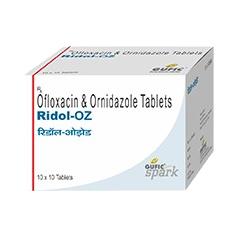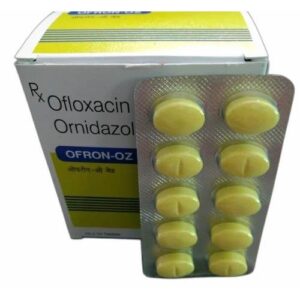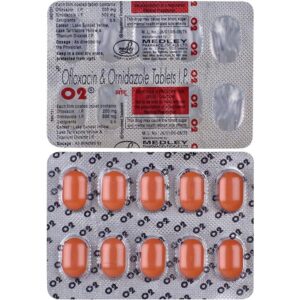ORNIDAZOLE + OFLOXACIN
Ornidazole: Ornidazole is an antimicrobial drug used to treat a variety of infections caused by anaerobic bacteria and protozoa. It is primarily prescribed for the treatment of conditions such as bacterial vaginosis, trichomoniasis, amoebiasis, and giardiasis.
The mechanism of action of ornidazole involves damage to the DNA and proteins of the microorganisms. It is converted into its active form inside the bacterial or protozoal cells, where it interacts with the DNA to cause breakage, leading to the disruption of the microorganisms’ genetic material. This ultimately inhibits their growth and proliferation.
The dose of ornidazole varies depending on the specific infection being treated. Typically, the recommended dosage ranges from 500 mg to 2 grams orally, usually taken as a single dose or divided into smaller doses taken over a certain duration. It is essential to follow the prescribed dosage and complete the entire course of treatment to effectively eradicate the infection.
Common side effects of ornidazole include nausea, vomiting, stomach discomfort, headache, dizziness, and a metallic taste in the mouth. These side effects are usually mild and temporary. However, if any of these side effects persist or worsen, it is important to consult a healthcare professional.
In some rare cases, ornidazole may cause more severe side effects such as allergic reactions, numbness or tingling in the extremities, seizures, or changes in vision. If any of these occur, immediate medical attention should be sought.
Ornidazole may also interact with certain medications, including blood thinners, disulfiram, and alcohol, leading to potential adverse effects. It is crucial to inform the healthcare provider about any other medications being taken to avoid potential drug interactions.
Overall, ornidazole is an effective antimicrobial drug used to treat various infections caused by anaerobic bacteria and protozoa. It is important to use the drug as prescribed and be aware of potential side effects or drug interactions.
Ofloxacin: Ofloxacin is a fluoroquinolone antibiotic that is primarily used to treat bacterial infections. It is effective against a wide range of bacteria, including those that cause urinary tract infections, respiratory tract infections, skin and soft tissue infections, and sexually transmitted infections such as gonorrhea.
The mechanism of action of ofloxacin involves inhibiting the bacterial DNA gyrase enzyme, which is responsible for the replication and repair of DNA in bacteria. By interfering with this enzyme, ofloxacin prevents the bacteria from effectively multiplying and spreading, leading to their eventual death.
The typical recommended dose of ofloxacin varies depending on the specific infection being treated. However, in most cases, the usual adult dose is between 200-400 mg taken orally twice daily. The length of treatment may also vary, ranging from a few days to a couple of weeks, depending on the severity and type of infection.
Like all medications, ofloxacin can cause side effects. Common side effects include nausea, diarrhea, headache, dizziness, and skin rashes. It is important to inform a healthcare provider if these side effects become severe or persistent. Ofloxacin may also have potentially serious side effects such as tendon rupture, especially in elderly patients or those who have a history of tendon disorders. It may also cause photosensitivity, making the skin more sensitive to sunlight, so it is advisable to use sun protection while taking this medication.
Ofloxacin is a prescription-only medication and should be taken only under the guidance of a healthcare professional. It is crucial to complete the full course of treatment as prescribed, even if the symptoms improve, to ensure the eradication of the infection and reduce the risk of developing antibiotic resistance.




